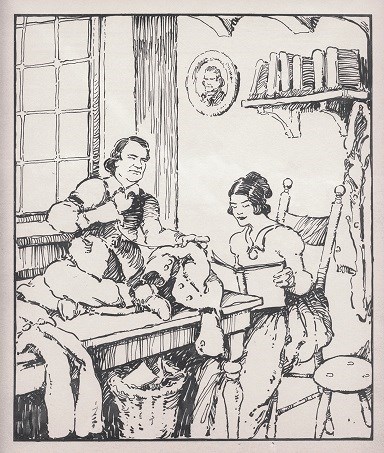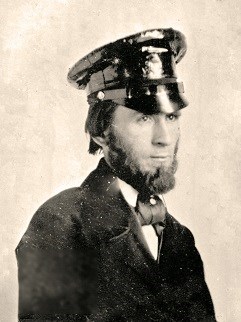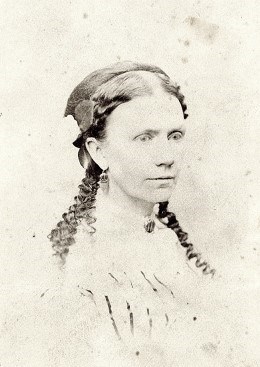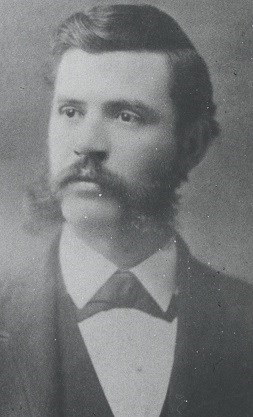"There goes my beau, girls, mark it." Eliza McCardle
NPS Image Andrew and ElizaAndrew Johnson was a poor journeyman tailor when he came into Greeneville, TN in September, 1826. He had crossed North Carolina and the Appalachian mountains, and had just descended into the first town in the broad valley below. He found a thriving town with an abundance of springs, and he and his mother and step-father camped at one overnight. Eliza McCardle was a local girl who had been educated at the Rhea female academy. Her father, an inn-keeper and shoemaker, had died, but she and her mother had kept up the tradition of making sandals for people in town. She must have seen some potential in the determined young man who had come to town, for she told her friends, "There goes my beau, girls, mark it." She was right. Within a year, Andrew and Eliza were wed by the local justice of the peace, Mordecai Lincoln. In a stroke of irony, Mordecai was a relative of Abraham Lincoln. At that point, none of them knew how that name would impact their lives. Eliza is often given credit for teaching her husband to read and write, but Andrew had the rudiments of an education when the two met. She definitely helped further and refine her husband's education, and she read to him in the Tailor Shop while he worked. 
NPS Photos
Andrew and Eliza remain the youngest presidential couple to wed. Andrew was eighteen; Eliza was sixteen. The next year their first child, Martha Johnson, was born.

NPS Image Martha Johnson (Patterson)
The Pattersons joined Andrew and Eliza and the rest of the family members that were in Nashville during the Civil War. When Lincoln was assassinated, Martha wrote her father, "My dear, dear Father ~ The sad, sad news has just reached us, announcing the death of President Lincoln's. Are you safe, and, do you feel secure?" 
NPS Image Charles JohnsonCharles Johnson was born February 19, 1830. He served as co-editor for a paper named The Greeneville Spy for a year, but he later became a partner in a drug store venture. He seems to have had a philosophical turn of mind, but he also turned to drink at an early age. Charles sympathized with the Union during the Civil War, though at one point he took an oath of allegiance to the Confederacy, likely in a failed attempt to preserve family property. When his mother was forced to leave East Tennessee and join Andrew Johnson in Nashville, he accompanied the family on the tedious journey. In the fall of 1862, Charles joined the 10th Tennessee Infantry as an Assistant Surgeon. Tragically, on April 4, 1863, Charles was thrown from a horse and died from head injuries. 
NPS Image Mary Johnson (Stover)Mary Johnson was born May 8, 1832. More lighthearted than her older sister Martha, Mary attended the Oddfellow's School in Rogersville, TN. On April 7, 1852, she married Daniel Stover from Carter County and moved to his farm there. The couple had three children, Lillie, Sarah, and Andrew Johnson Stover. During the Civil War, Daniel took part in bridge burning activities. This attempt to sabotage the railroad for the Confederacy was intended to coincide with a Union invasion to liberate East Tennessee. When the invasion didn't take place, the bridge burners were forced to take refuge in the mountains over a cold winter. He died from tuberculosis on December 18, 1864 in Nashville, where the family had joined Military Governor Andrew Johnson and Daniel was serving as Colonel of the 4th TN Infantry. The widowed Mary accompanied the family to the White House, where she assisted her sister with hostess duties. She returned home before the rest of the family to prepare the war-damaged Homestead. On April 20,1869, Mary married neighbor William Brown, but the marriage ended in divorce after the deaths of her parents. Mary used her inheritance to buy property in Tennessee and Texas. She traveled to Texas to manage affairs there and built a large home in East Tennessee. 
NPS Image Robert JohnsonRobert Johnson was born February 22, 1834. He was the youngest child for eighteen years. He went through a variety of occupations in Greeneville such as serving as a store clerk and studying law. He developed an interest in politics and was elected to represent four counties in the Tennessee state legislature from 1859-1861. Robert escaped arrest for his Unionist stance during the early part of the Civil War by hiding out at a local farm and in the mountains. He made it to Kentucky in February 1862, and by March he was Colonel Robert Johnson of the 4th TN Infantry. The unit designation was later changed to the 1st TN Cavalry. He resigned his post in May 1864 and became secretary to his father, both in Nashville and Washington. Unfortunately, Robert suffered from tuberculosis and alcoholism and spent time during his father's presidency in a Washington asylum. He died just a month after the family's return to Greeneville at the age of 35. 
NPS Image Andrew Johnson Jr. ~ "Frank"Andrew Johnson Jr. was the youngest Johnson son by eighteen years. He was born August 5, 1852, after the family had moved into the larger Homestead on Main Street. Frank's education was sporadic, first because of the Civil War, then because of the family's political moves. He attended the Vermonth Episcopal School in Burlington, VT in 1865-66. In 1866-1869 he attended Georgetown College, a Catholic school. When the family returned to Greeneville, Frank co-edited a newspaper called The Greeneville Intelligencer with his nephew-in-law. Frank was the only Johnson son to marry. He married Kate May "Bessie" Rumbough in Warm Springs (now Hot Springs), NC on November 25, 1875. The marriage was strained, as Frank suffered from tuberculosis and drank to excess. He died on March 12, 1879 at the age of 26, having no children. |
Last updated: April 11, 2024
